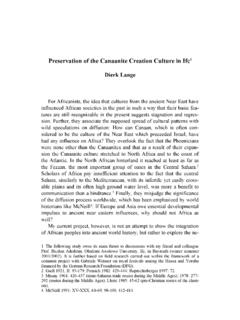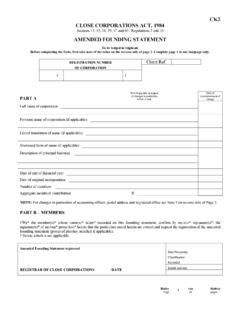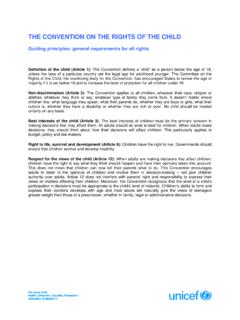Transcription of Working Papers in African Studies No. 265 - Dierk …
1 Working Papers in African Studies No. 265 The founding of Kanem by Assyrian Refugees ca. 600 BCE: Documentary, Linguistic, and Archaeological Evidence D i e r k L a n g e Working Papers in African Studies African Studies Center Boston University 2011 The opinions expressed in this publication are those of the author and do not necessarily reflect the views of Boston University or the African Studies Center. Series Editor: Michael DiBlasi Production Manager: Sandra McCann African Studies Center Boston University 232 Bay State Road Boston, MA 02215 Tel: 617-353-7306 Fax: 617-353-4975 E-mail: Web: 2011, by the author ii Working Papers in African Studies No.
2 265 (2011) The founding of Kanem by Assyrian Refugees ca. 600 BCE: Documentary, Linguistic, and Archaeological Evidence By Dierk Lange* The history of Kanem-Bornu has received relatively little attention for a number of decades, but recent archaeological research in West Africa has renewed interest in the topic. The unexpectedly early date of the emergence of proto-urban settlements south of Lake Chad in the middle of the first millennium BCE is particularly In the Western Sudan the emergence of the city of Jenne-Jeno along the eastern arm of the Inner Niger Delta in the third century BCE has given rise to the idea that Ghana, supposedly the oldest state in West Africa, was founded at the same If we assume a connection between urbanism and state-building, the foundation of Kanem in the region of Lake Chad (the early nucleus of the Kanem-Bornu Empire)
3 May likewise have been much earlier than hitherto supposed. Members of the German culture historical school were convinced that states in West Africa originated in pre-Roman times as a result of Near Eastern or Mediterranean influences. They noted surprising similarities between the institutions of surviving traditional states all over Africa and therefore believed in a vast movement of diffusion. However, their historical considerations were highly unsatisfactory in that they referred to northern or eastern origins and vague, undated streams and waves of As a consequence of the independence of African peoples in the 1960s, the decolonization of African history put a stop to speculation concerning unspecified cultural influences having reached sub-Saharan Africa from the north or the northeast.
4 Instead, the focus of attention for finding an origin for state development shifted to the Nile valley, where the Egyptian civilization survived in its southern outpost Meroe until the fourth century CE. From here, pastoral migrants reinforced * I am grateful to Dr. Klaus Schubert, University of Munich, for his insights on the linguistic aspects of this paper , and to my research assistant Thorsten Parchent for discussions on its historical aspects. Date of submission: 3/9/2009. 1 C. Magnavita, Zilum: Towards the emergence of socio-political complexity in the Lake Chad region, in M.
5 Krings and E. Platte, eds., Living with the Lake (Cologne: R. K ppe, 2004), 73 100; P. Breunig et al., [seven more names] Glanz ohne Eisen: Gro e Siedlungen aus der Mitte des ersten Jahrtausends BC im Tschadbecken von Nordost-Nigeria, in Wotzka, ed., Grundlegungen. Beitr ge zur europ ischen und afrikanischen Arch ologie (T bingen: Francke, 2006), 255 270. 2 R. Oliver and Fage, A Short History of Africa, 6th ed. (1st ed. 1962) (London: Penguin, 1988), 35; C. Ehret, The Civilizations of Africa: A History to 1800 (Oxford: J. Currey, 2002), 232. 3 H. Baumann, V lker und Kulturen Afrikas, in H.
6 Baumann et al., eds., V lkerkunde von Afrika (Essen: Verlagsanstalt, 1940), 56 71; D. Westermann, Geschichte Afrikas (Cologne: Greven, 1952), 30 71. 2 Dierk Lange by South Arabian elements were supposed to have contributed to the transfer of a foreign state to West Africa. As for the period of transmission, a date just prior to the spread of Christianity and Islam was suggested. However, it remained unclear who transmitted which kind of polity in what period: an Egyptian state from the Nile valley, a Semitic state from Arabia, or even a Persian state from Iran?4 Ideas proposing migration or diffusion as the main vector introducing the state to sub-Saharan Africa were also met with criticism due to the uncertainties concerning the time and the circumstances of the suggested cultural transfer.
7 Though the structural similarities among surviving African kingdoms still await explanation, historians of the postcolonial period disregard the anthropological evidence and tend to explain the origin of kingdoms and complex societies by three different factors: first, the intensification of trans-Saharan trade due to the introduction of the camel around 300 CE and the need to protect long-distance trade against marauders; second, nomadic encroachments on sedentary societies south of the Sahara as a consequence of climatic deterioration and the conquest of peasant communities; third, the grouping together of various farmer communities in defence against endemic incursions by pastoral invaders from the desert However, these new explanatory factors are based on vague analogies and general suppositions that are not supported by oral or documentary evidence.
8 They are a reaction against the earlier diffusionist approach but do not take into consideration the wealth of internal sources available in regions such as the Central Sudan where the old kingdoms survived into modern times. Scholars have neglected the local written, linguistic, and anthropological data in the Central Sudan, and have concentrated on the more eventful history of the Western Sudan. However, owing to the destruction of the well-known states of Ghana and Songhay by conquests and the ruin of Mali in consequence of internal dissension, there are no significant documentary and institutional survivals providing insights on the history and organizational structures of these Therefore the glimpses of the sacred kingships of Ghana and early Gao offered by Arab geographers cannot be complemented by any study of remaining state structures.
9 Also, in Ghana and Mali there are no internal written documents that survived the collapse of these states. Such remnant historical texts and ancient organizational structures are however still to be found in the Central Sudan, as the major states of the region have survived until the present Before the coming of Islam the states were sacred or divine 4 Oliver and Fage, Short History, 31 38; Fage, A History of Africa (London: Hutchinson, 1978), 63 65. 5 P. Curtin, Africa north of the forest in the early Islamic age, in Ph. Curtin et al.
10 , eds., African History, 2nd ed. (1st ed. 1978), 73-97; Fage, History, 57 72. 6 N. Levtzion, Ancient Ghana and Mali (London: Methuen, 1973), 43-52, 94 102; S. Trimingham, A History of Islam in West Africa (London, Oxford: University Press, 1962), 55 60, 144 47; Fage, History, 71 72, 76 81, 179 81. 7 The best examples are the D3w1n of Kanem-Bornu and the Kano Chronicle. See D. Lange, Le D3w1n des sultans du Kanem-Bornu: Chronologie et histoire d un royaume africain (Wiesbaden: F. Steiner, 1977), 22 82 and Palmer, Sudanese Memoirs, vol. III (Lagos: Government Printer, 1928), 97 132.










